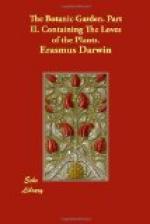With still small voice the plots of Guilt alarms,
Bares his mask’d brow, his lifted hand disarms;
But, wrapp’d in night with terrors all his own,
He speaks in thunder, when the deed is done.
455 Hear him ye Senates! hear this truth sublime,
“HE, WHO ALLOWS OPPRESSION, SHARES THE CRIME.”
No
radiant pearl, which crested Fortune wears,
No
gem, that twinkling hangs from Beauty’s ears,
Not
the bright stars, which Night’s blue arch adorn,
460 Nor rising suns that gild the vernal morn,
Shine
with such lustre as the tear, that breaks
For
other’s woe down Virtue’s manly cheeks.”
Here
ceased the MUSE, and dropp’d her tuneful shell,
Tumultuous
woes her panting bosom swell,
465 O’er her flush’d cheek her gauzy
veil she throws,
Folds
her white arms, and bends her laurel’d brows;
For
human guilt awhile the Goddess sighs,
And
human sorrows dim celestial eyes.
INTERLUDE III.
Bookseller. Poetry has been called a sister-art both to Painting and to Music; I wish to know, what are the particulars of their relationship?
Poet. It has been already observed, that the principal part of the language of poetry consists of those words, which are expressive of the ideas, which we originally receive by the organ of sight; and in this it nearly indeed resembles painting; which can express itself in no other way, but by exciting the ideas or sensations belonging to the sense of vision. But besides this essential similitude in the language of the poetic pen and pencil, these two sisters resemble each other, if I may so say, in many of their habits and manners. The painter, to produce a strong effect, makes a few parts of his picture large, distinct, and luminous, and keeps the remainder in shadow, or even beneath its natural size and colour, to give eminence to the principal figure. This is similar to the common manner of poetic composition, where the subordinate characters are kept down, to elevate and give consequence to the hero or heroine of the piece.
In the south aile of the cathedral church at Lichfield, there is an antient monument of a recumbent figure; the head and neck of which lie on a roll of matting in a kind of niche or cavern in the wall; and about five feet distant horizontally in another opening or cavern in the wall are seen the feet and ankles, with some folds of garment, lying also on a matt; and though the intermediate space is a solid stone-wall, yet the imagination supplies the deficiency, and the whole figure seems to exist before our eyes. Does not this resemble one of the arts both of the painter and the poet? The former often shows a muscular arm amidst a group of figures, or an impassioned face; and, hiding the remainder of the body behind other objects, leaves the imagination to compleat it. The latter, describing a single feature or attitude in picturesque words, produces before the mind an image of the whole.




